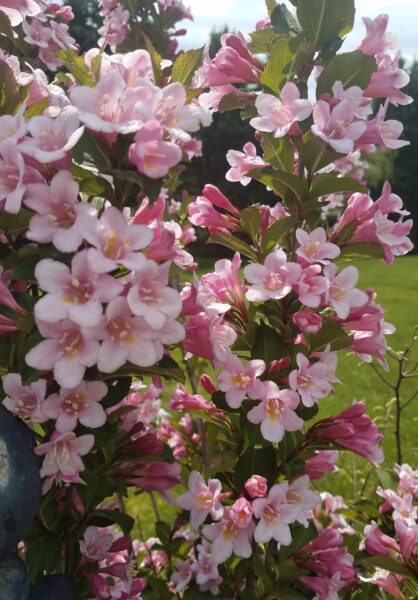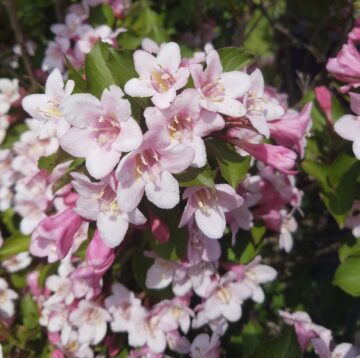Many varieties of flowering shrubs paint the landscapes of Central Virginia with splashes of color in springtime. Just the mention of forsythias, azaleas, and lilacs bring to mind a variety of vibrant blooms.

One shrub that may not be as familiar is weigela, (wy-GEE-la). Often called “old-fashioned weigela”, Weigela florida is a dense, rounded, deciduous shrub. Native to northern China, Korea, and Japan, it was taken to Europe in the 1840s and then brought to America in the 1860s. Hybridization and cultivation of the plant has taken place since the 1840s. Today, there are more than 170 cultivars of weigela.
Weigela blooms profusely in late spring. Depending on the cultivar, the tubular-shaped blooms may be pink, red, burgundy, yellow, or white. Blooms measure between 1.25 to 2 inches long and attract hummingbirds and other pollinators. Weigela may re-bloom sparsely during the summer. Its leaves are oblong and measure 3 to 6 inches long. They may be various shades of green, burgundy, or variegated.
For the most blooms, plant weigela in soil with good drainage, where the shrub will be in full sun for at least 6 hours per day. Weigela will bloom in partial sun, but will not have as many flowers. It will tolerate clay soil and is resistant to salt. Fertilize once a year, in late winter, with a balanced fertilizer such as 10-10-10.
Weigela may be used as a stand-alone shrub or in a hedge. Old-fashioned weigela may grow up to 10 feet tall and 12 feet wide. If you are planning a hedgerow, check the plant data for size information of the plant you are purchasing. Weigela does not like to be crowded, so it is important to know how wide the plant will grow and space plants accordingly. Dwarf cultivars, such as weigela ‘Pink Poppet’, grow 1.5 to 2 feet tall and up to 2 feet wide. They may be used in containers and tolerate occasional drought.

Prune weigela for shape in spring after the shrub has bloomed. Mature plants will benefit from having old interior branches pruned to the base of the plant once every 2-3 years in late winter. Weigela is not usually affected by pests or by disease. It is also deer resistant.
Propagation is easily done by layering or from softwood stem cuttings during late spring or early summer.
Weigela, with its large variety of cultivars, is becoming more popular. Once established this shrub is hardy and low maintenance. Its showy springtime blooms will bring a splash of color to any landscape.
Author: Linda Evans, Bedford Area Master Gardener